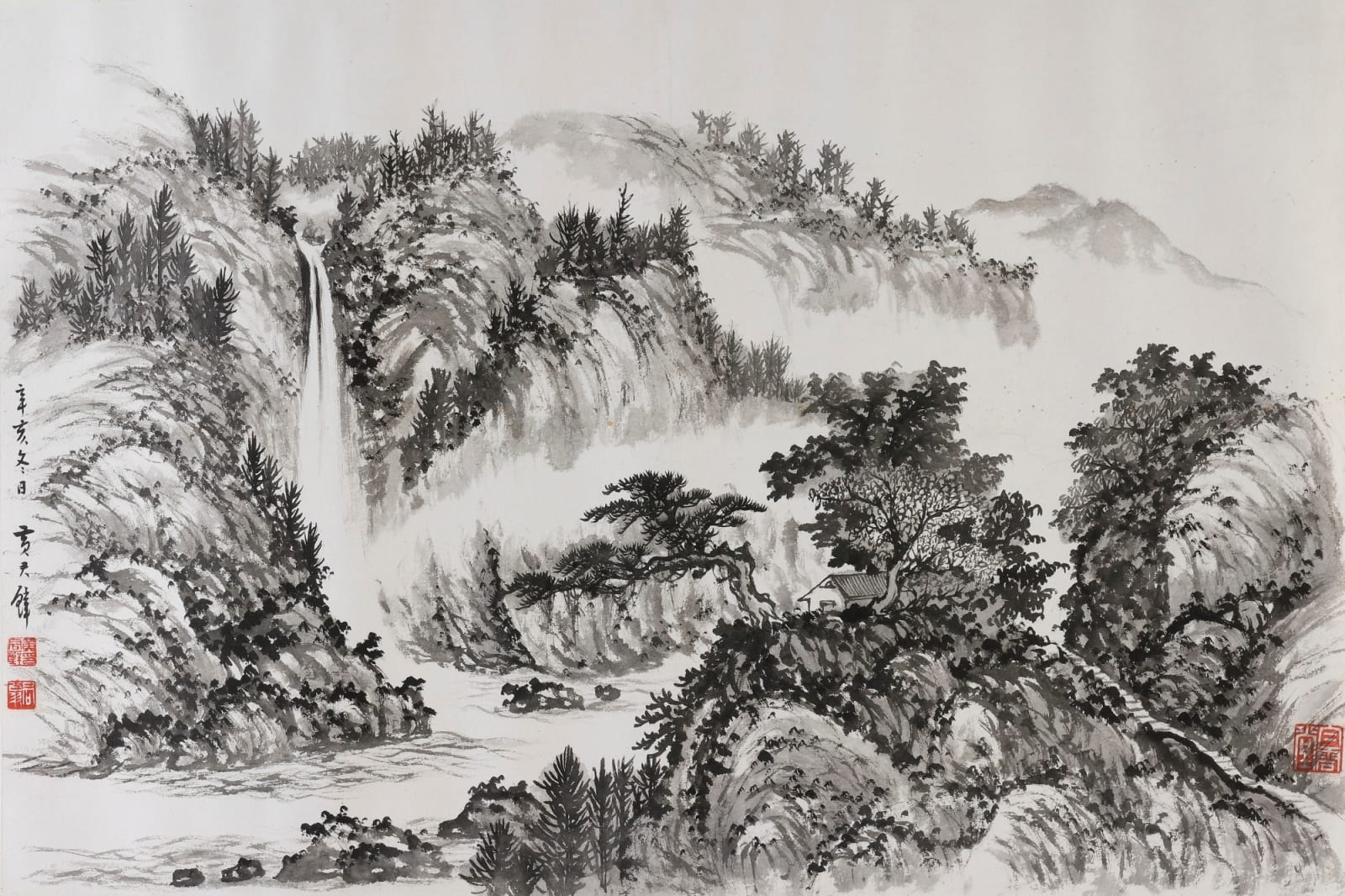-
作品

Huang Junbi
空山飛瀑, 1971ink on paper, mounted for framing19 1/2 x 29 in
49.5 x 73.7 cmCopyright The Artist黄君璧(1898-1991)作为二十世纪中国艺术界的著名画家与教育家,以传统山水画的深厚造诣和现代艺术教育的推广而闻名。1948年迁居台湾后,他主持台湾师范大学美术系长达二十二年,推动了传统艺术教育的现代化,对台湾地区的艺术创作和教育产生了深远的影响。与张大千、溥心畲并称「渡海三家」,黄君璧以其沉稳朴厚、清新淳雅的笔墨风格自成一格。 至1970年代初,黄君璧的艺术风格愈加成熟,作品愈发雄浑壮丽。他在年近古稀之际汲取自然精华,将壮观的自然景象与个人情怀融入画中,创作出既传承山水画静谧自然之美,又兼具现代审美的作品。黄君璧尤以云山飞瀑为题材,展现出磅礴气势与层次分明的结构。他的笔法稳健细腻,墨色层次变化丰富,尤其在瀑布表现上极具张力,笔触浓淡相宜,既有厚重之感,又不失清雅之韵。本件作品不同于他晚期常见的工整风格,属于更加写意的一类,奠基于其传统云山飞瀑作品的基础之上,并于其中融入了更为自由的挥洒,而一切仍然遵循传统章法。正是这种稳健与自由的平衡,彰显了笔墨艺术的蓬勃生命力与创新精神。 As a renowned artist and educator in 20th-century Chinese art, Huang Junbi (1898-1991) was celebrated for his mastery of traditional landscape painting and his dedication to advancing modern...黄君璧(1898-1991)作为二十世纪中国艺术界的著名画家与教育家,以传统山水画的深厚造诣和现代艺术教育的推广而闻名。1948年迁居台湾后,他主持台湾师范大学美术系长达二十二年,推动了传统艺术教育的现代化,对台湾地区的艺术创作和教育产生了深远的影响。与张大千、溥心畲并称「渡海三家」,黄君璧以其沉稳朴厚、清新淳雅的笔墨风格自成一格。
至1970年代初,黄君璧的艺术风格愈加成熟,作品愈发雄浑壮丽。他在年近古稀之际汲取自然精华,将壮观的自然景象与个人情怀融入画中,创作出既传承山水画静谧自然之美,又兼具现代审美的作品。黄君璧尤以云山飞瀑为题材,展现出磅礴气势与层次分明的结构。他的笔法稳健细腻,墨色层次变化丰富,尤其在瀑布表现上极具张力,笔触浓淡相宜,既有厚重之感,又不失清雅之韵。本件作品不同于他晚期常见的工整风格,属于更加写意的一类,奠基于其传统云山飞瀑作品的基础之上,并于其中融入了更为自由的挥洒,而一切仍然遵循传统章法。正是这种稳健与自由的平衡,彰显了笔墨艺术的蓬勃生命力与创新精神。As a renowned artist and educator in 20th-century Chinese art, Huang Junbi (1898-1991) was celebrated for his mastery of traditional landscape painting and his dedication to advancing modern art education. After relocating to Taiwan in 1948, he led the Fine Arts Department at National Taiwan Normal University for 22 years, championing the modernization of traditional art education and leaving a profound impact on art creation and education in Taiwan. Alongside Zhang Daqian and Pu Ru, he became known as one of the “Three Masters Across the Sea,” developing a distinctive style characterized by solid, harmonious brushstrokes that conveyed elegance and simplicity.
By the early 1970s, as his style reached full maturity, Huang’s work took on an increasingly grand and powerful tone. Approaching his seventies, he drew inspiration from nature, blending vast landscapes with his own emotions to produce compositions that fused traditional serenity with modern aesthetics. Known for his depictions of towering mountains and cascading waterfalls, his works from this period reveal an impressive momentum and sophisticated structure. His steady, delicate brushwork and varied ink layers—especially in his rendering of waterfalls—achieve both weight and elegance, showing a balance of expressive freedom and traditional form. This piece, distinct from his typical late-period works, exemplifies his more liberated freehand style, built upon his traditional mountain and waterfall scenes. It is through this balance of mastery and expressive freedom that Huang’s work speaks to the enduring vitality and innovation of brush and ink.
订阅邮件
* denotes required fields
We will process the personal data you have supplied to communicate with you in accordance with our Privacy Policy. You can unsubscribe or change your preferences at any time by clicking the link in our emails.

